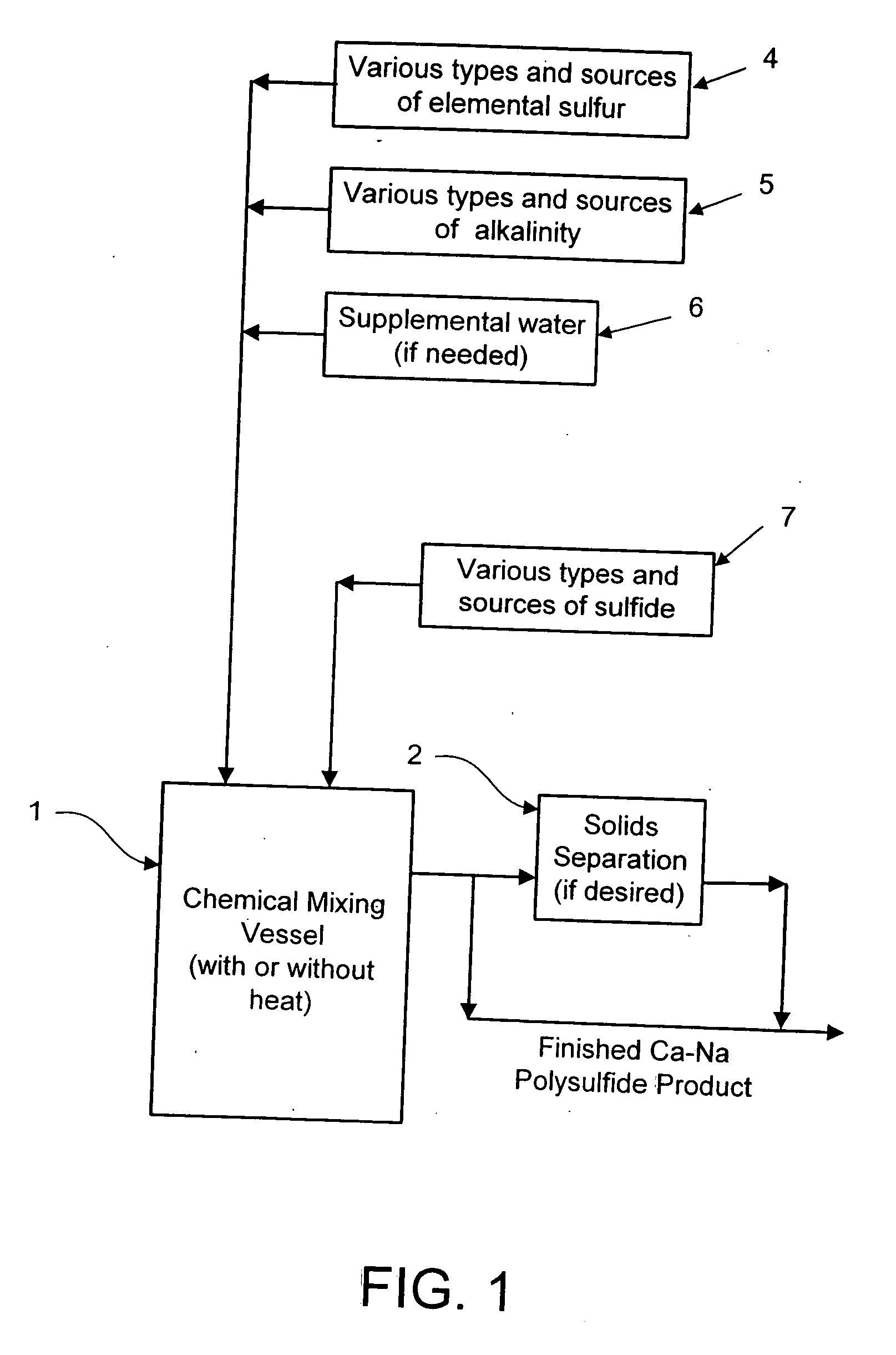Calcium-sodium ploysulfide chemical reagent and production methods
a technology of calcium sulfide and chemical reagent, which is applied in the field of polysulfide reagents, can solve the problems of low polysulfide yield, undesirable methods based on the above reaction, and application limitations to relative dilutes
- Summary
- Abstract
- Description
- Claims
- Application Information
AI Technical Summary
Benefits of technology
Problems solved by technology
Method used
Image
Examples
example 1
[0045]In this example, a calcium-sodium polysulfide reagent was produced by combining the raw materials to a single mixing tank or reactor in the manner illustrated in FIG. 1. More specifically, a full-scale test was performed to verify that the method was simple and rapid. The demonstration produced about 3,500 gallons of calcium-sodium polysulfide reagent having a specific gravity of 1.31 and a total sulfur content of about 27%. The production method involved adding about 1,150 gallons of water (including some steam condensate) to an enclosed reactor with a mixing device and then adding 3,000 lbs of calcium hydroxide. 18,160 lbs of 25% NASH solution was also added to the reactor. Live steam was briefly injected into the reactor to raise the temperature to 150° F. Next, approximately 7,840 lbs of elemental sulfur prills were added to the reactor and within less than an hour of mixing, the reaction was complete. The resultant product was deep red in color and had a specific gravity ...
example 2
[0046]In this example, the calcium-sodium polysulfide reagent produced in Example 1 was tested for its ability to stabilize chromite ore processing residue (COPR) containing high levels of chrome. The applicability of the calcium-sodium polysulfide reagent to stabilize chrome residues was verified by applying various doses of the calcium-sodium polysulfide reagent to three different samples of chromite ore processing residue (COPR). The three samples used in this experiment had the following total chrome contents: COPR-1=1.8% Cr, COPR-3=2.4% Cr and COPR-4 of 1.3%. In accordance with Environmental Protection Agency (EPA) requirements for this type of waste material, the concentration of chrome in the leachate from the TCLP (toxicity characteristic leachate procedure) test protocol must be less than 0.60 mg / L after stabilization. The untreated TCLP leachate chrome concentrations for the three samples ranged from 40 mg / L to 100 mg / L. The results of the tests which included treating the...
example 3
[0048]In this example, a calcium-sodium polysulfide reagent was produced by combining the raw materials to a single mixing tank or reactor in the manner illustrated in FIG. 2. More specifically, a bench-scale test was conducted in which 74.5 grams of a sulfur filter cake (containing about 75% sulfur) was placed into 36 mL of tap water and stirred. 43.2 grams of lime filter cake (about 50% solids) was then added to the mixture and the resulting mixture was mixed to form a pumpable slurry. The slurry was transferred into a beaker to which 54.6 mL of 45% NaSH was then added and then an additional 39 mL of tap water was added. Within a few minutes after stirring at room temperature the slurry had completely reacted producing a deep-red calcium-sodium polysulfide alkaline reagent. The reagent had a specific gravity of 1.32 and a total sulfur content of 24.6%.
PUM
| Property | Measurement | Unit |
|---|---|---|
| molar ratio | aaaaa | aaaaa |
| room temperature | aaaaa | aaaaa |
| specific gravity | aaaaa | aaaaa |
Abstract
Description
Claims
Application Information
 Login to View More
Login to View More - R&D
- Intellectual Property
- Life Sciences
- Materials
- Tech Scout
- Unparalleled Data Quality
- Higher Quality Content
- 60% Fewer Hallucinations
Browse by: Latest US Patents, China's latest patents, Technical Efficacy Thesaurus, Application Domain, Technology Topic, Popular Technical Reports.
© 2025 PatSnap. All rights reserved.Legal|Privacy policy|Modern Slavery Act Transparency Statement|Sitemap|About US| Contact US: help@patsnap.com


